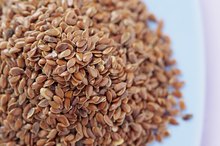Milled vs. Ground Flaxseed
High in dietary fiber, rich in alpha-linolenic acid and brimming with antioxidant lignans, flaxseed helps maintain bowel regularity, promotes healthy cholesterol levels and protects against cardiovascular disease. Because these benefits are packaged in a hard seed coat that’s difficult to crack, however, whole flaxseed should be ground or milled into flaxseed meal for consumption 3.
What’s in a Label?
The words “ground” and “milled” can be used interchangeably to describe whole flaxseed that has been pulverized into fine granules, also known as flaxseed meal. Although the term “milled flaxseed” is often used on products that have been ground on a commercial scale, commercially processed flaxseed may also be labeled as ground flaxseed or flaxseed meal.
Cold-Milled Flaxseed
Calories in Two Tablespoons of Ground Flaxseed
Learn More
The high levels of polyunsaturated fatty acids that make flaxseed so beneficial are also what give it a short shelf life, especially once it’s ground -- the oils in flaxseed meal have an increased surface area and are therefore more prone to oxidation and quick rancidity 3. Because heat speeds up the process, some companies produce “cold-milled” flaxseed, or flaxseed that’s been ground at room temperature. Cold-milled flaxseed has a longer shelf life than the traditionally milled variety, which is exposed to higher temperatures during processing.
Other Considerations
To keep yourself from consuming rancid flaxseed meal, which may be inflammatory and potentially carcinogenic, it’s best to buy whole flaxseed and grind it in a food processor or dedicated coffee grinder as you need it 3. Unused flaxseed meal -- whether freshly ground or commercially milled -- should be stored in the freezer; if it smells like oil paint or crayons, it’s rancid 3.
Related Articles
References
- USDA National Nutrient Database: Seeds, Flaxseed
- University of Maryland Medical Center: Flaxseed
- Bob’s Red Mill Natural Foods: Flaxseed Meal
- Chicago Tribune: Has Your Food Gone Rancid?
- Wellness Foods A to Z: An Indispensable Guide for Health-Conscious Food Lovers; Sheldon Margen, M.D.
- Goyal A, Sharma V, Upadhyay N, Gill S, Sihag M. Flax and flaxseed oil: an ancient medicine & modern functional food. J Food Sci Technol. 2014;51(9):1633-53. doi:10.1007/s13197-013-1247-9
- Ren GY, Chen CY, Chen GC, et al. Effect of flaxseed intervention on inflammatory marker C-reactive protein: A systematic review and meta-analysis of randomized controlled trials. Nutrients. 2016;8(3):136. doi:10.3390/nu8030136
- Okinyo-Owiti DP, Dong Q, Ling B, et al. Evaluating the cytotoxicity of flaxseed orbitides for potential cancer treatment. Toxicol Rep. 2015;2:1014-1018. doi:10.1016/j.toxrep.2015.06.011
- Lowcock EC, Cotterchio M, Boucher BA. Consumption of flaxseed, a rich source of lignans, is associated with reduced breast cancer risk. Cancer Causes Control. 2013;24(4):813-6. doi:10.1007/s10552-013-0155-7
- Ramos CI, Andrade de Lima AF, Grilli DG, Cuppari L. The short-term effects of olive oil and flaxseed oil for the treatment of constipation in hemodialysis patients. J Ren Nutr. 2015;25(1):50-6. doi:10.1053/j.jrn.2014.07.009
- Styrczewska M, Kostyn A, Kulma A, et al. Flax fiber hydrophobic extract inhibits human skin cells inflammation and causes remodeling of extracellular matrix and wound closure activation. Biomed Res Int. 2015;2015:862391. doi:10.1155/2015/862391
- Ibrügger S, Kristensen M, Mikkelsen MS, Astrup A. Flaxseed dietary fiber supplements for suppression of appetite and food intake. Appetite. 2012;58(2):490-5. doi:10.1016/j.appet.2011.12.024
- Cetisli NE, Saruhan A, Kivcak B. The effects of flaxseed on menopausal symptoms and quality of life. Holist Nurs Pract. 2015;29(3):151-7. doi:10.1097/HNP.0000000000000085
- National Center for Complementary and Integrative Health. Flaxseed and flaxseed oil. Updated September 2016.
- O'Keefe A, Kapur S, Rex G, Watson W. Flax seed allergy in children: an emerging allergen? Allergy Asthma Clin Immunol. 2010; 6(Suppl 2):P6. doi:10.1186/1710-1492-6-S2-P6
- Hackshaw-McGeagh LE, Perry RE, Leach VA, et al. A systematic review of dietary, nutritional, and physical activity interventions for the prevention of prostate cancer progression and mortality. Cancer Causes Control. 2015;26(11):1521-50. doi:10.1007/s10552-015-0659-4
- Carleton AJ, Sievenpiper JL, De Souza R, McKeown-Eyssen G, Jenkins DJ. Case-control and prospective studies of dietary α-linolenic acid intake and prostate cancer risk: a meta-analysis. BMJ Open. 2013;3(5). doi:10.1136/bmjopen-2012-002280
- Setayesh M, Sadeghifar AR, Nakhaee N, Kamalinejad M, Rezaeizadeh H. A topical gel from flax seed oil compared with hand splint in carpal tunnel syndrome: A randomized clinical trial. J Evid Based Complementary Altern Med. 2017;22(3):462-467. doi:10.1177/2156587216677822
- UW Medicine Anesthesiology and Pain Medicine. Medications to avoid before surgery.
- Mount Sinai Health Library. Flaxseed oil.
- Kajla P, Sharma A, Sood DR. Flaxseed--a potential functional food source. J Food Sci Technol. 2015;52(4):1857-71. doi:10.1007/s13197-014-1293-y
- Cockerell KM, Watkins AS, Reeves LB, Goddard L, Lomer MC. Effects of linseeds on the symptoms of irritable bowel syndrome: a pilot randomised controlled trial. J Hum Nutr Diet. 2012;25(5):435-43. doi:10.1111/j.1365-277X.2012.01263.x
- Kaithwas G, Majumdar DK. Effect of L. usitatissimum (flaxseed/linseed) fixed oil against distinct phases of inflammation. ISRN Inflamm. 2013;2013:735158. doi:10.1155/2013/735158
- Ward HA, Kuhnle GG, Mulligan AA, Lentjes MA, Luben RN, Khaw KT. Breast, colorectal, and prostate cancer risk in the European Prospective Investigation into Cancer and Nutrition-Norfolk in relation to phytoestrogen intake derived from an improved database. Am J Clin Nutr. 2010;91(2):440-8. doi:10.3945/ajcn.2009.28282
Writer Bio
Based just outside Chicago, Meg Campbell has worked in the fitness industry since 1997. She’s been writing health-related articles since 2010, focusing primarily on diet and nutrition. Campbell divides her time between her hometown and Buenos Aires, Argentina.









